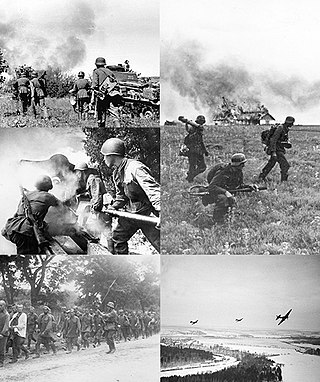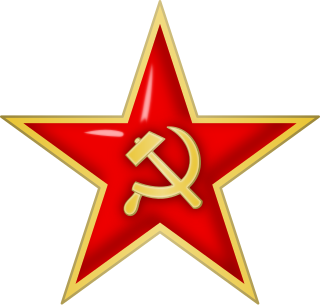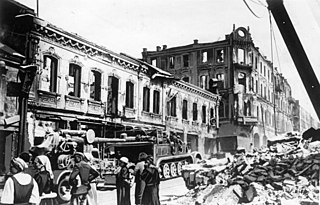
Operation Barbarossa was the invasion of the Soviet Union by Nazi Germany and many of its Axis allies, starting on Sunday, 22 June 1941, during World War II. It was the largest and costliest land offensive in human history, with around 10 million combatants taking part, and over 8 million casualties by the end of the operation.

The Battle of Moscow was a military campaign that consisted of two periods of strategically significant fighting on a 600 km (370 mi) sector of the Eastern Front during World War II, between October 1941 and January 1942. The Soviet defensive effort frustrated Hitler's attack on Moscow, the capital and largest city of the Soviet Union. Moscow was one of the primary military and political objectives for Axis forces in their invasion of the Soviet Union.

Aleksandr Mikhaylovich Vasilevsky was a Soviet career-officer in the Red Army who attained the rank of Marshal of the Soviet Union in 1943. He served as the Chief of the General Staff of the Soviet Armed Forces (1942–1945) and Deputy Minister of Defense during World War II, and as Minister of Defense from 1949 to 1953. As the Chief of the General Staff from 1942 to 1945, Vasilevsky became involved in planning and coordinating almost all the decisive Soviet offensives in World War II, from the Operation Uranus of November 1942 to the assaults on East Prussia, Königsberg and Manchuria.

The Western Front was a front of the Red Army, one of the Red Army Fronts during World War II.

The Battle of Białystok–Minsk was a German strategic operation conducted by the Wehrmacht's Army Group Centre under Field Marshal Fedor von Bock during the penetration of the Soviet border region in the opening stage of Operation Barbarossa, lasting from 22 June to 9 July 1941.

The Northwestern Front was a military formation of the Red Army during the Winter War and World War II. It was operational with the 7th and 13th Armies during the Winter War. It was re-created on 22 June 1941, the first day of the Eastern Front on the basis of the Baltic Special Military District. On 22 June the Front consisted of the 8th, 11th, and 27th Armies, as well as the 5th Airborne Corps and the headquarters of the 65th Rifle Corps.

The second Smolensk operation was a Soviet strategic offensive operation conducted by the Red Army as part of the Summer-Autumn Campaign of 1943. Staged almost simultaneously with the Lower Dnieper Offensive, the offensive lasted two months and was led by General Andrei Yeremenko, commanding the Kalinin Front, and Vasily Sokolovsky, commanding the Western Front. Its goal was to clear the German presence from the Smolensk and Bryansk regions. Smolensk had been under German occupation since the first Battle of Smolensk in 1941.
The Bryansk Front was a major formation of the Red Army during the Second World War.
The Kalinin Front was a major formation of the Red Army active in the Eastern Front of World War II, named for the city of Kalinin. It was formally established by Stavka directive on 17 October 1941 and allocated three armies: 22nd, 29th Army and 30th. In May 1942, the Air Forces of the Kalinin Front were reorganised as the 3rd Air Army, comprising three fighter, two ground attack, and one bomber division.

The 10th Army of the Soviet Union's Red Army was a field army active from 1939 to 1944.
The Red Army's 33rd Army was a Soviet field army during the Second World War. It was disbanded by being redesignated HQ Smolensk Military District in 1945.
The 1st Guards Proletarian Moscow-Minsk Order of Lenin, twice Red Banner Orders of Suvorov (II) and Kutuzov (II) Motor Rifle Division was a division of the Red Army and Russian Ground Forces active from 1926 to 2002.

The 20th Army was a field army of the Red Army that fought on the Eastern Front during World War II.
The 43rd Army was a Red Army field army of World War II that served on the Eastern Front. Formed in late July 1941, the army fought in the Battle of Smolensk (1941). It was forced to retreat after German troops broke through in October 1941 and subsequently fought in the Battle of Moscow. The army then fought in the Rzhev-Vyazma Offensive. After the end of the offensive, the army held its positions and transferred to the Demidov area in late 1942. It fought in the Battle of Smolensk (1943). During the summer of 1944, the army fought in Operation Bagration. In the fall the army advanced into the Baltic region and fought in the Riga Offensive (1944) and the Battle of Memel. In 1945 the army fought in the East Prussian Offensive before being placed in reserve near the end of April. The 43rd Army was disbanded postwar in July 1946.
The 34th Guards Rifle Division was a rifle division of the Red Army during World War II.
The 5th Guards Rifle Division was an infantry division of the Red Army in World War II. It fought at Kaluga, Orel, Moscow, Bryansk, Gorodok, and in Belorussia, East Prussia, and Kurland.
The 265th Motor Rifle Division was a motorized infantry division of the Soviet Army during the Cold War.
The 263rd Rifle Division was an infantry division of the Red Army during World War II.
The 262nd Rifle Division was an infantry division of the Red Army during World War II.
The Donbas–Rostov Strategic Defensive Operation was a defensive operation of the Southern Front and the left wing of the South–Western Front of the Red Army on the territory of Donbas during the World War II. During it, the Donbas and Rostov front–line defensive operations were carried out.








